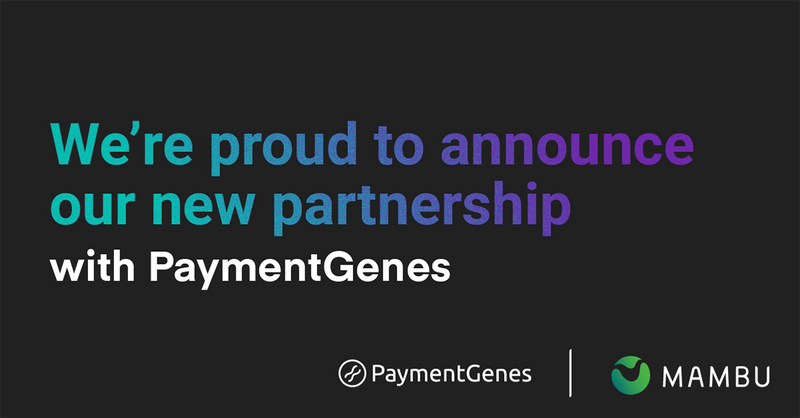PaymentGenes will offer Mambu’s customers with a selection of payments and card issuing solutions, card scheme membership or regulatory license applications towards product design and a certified implementation.

What can be expected from a partnership between Mambu and PaymentGenes?
With PaymentGenes being an internationally recognised consulting and recruitment service partner to the fintech and payments industry, I see great opportunity for both companies to help non-financial institutions who want to enter the financial services industry - such as the larger retailers and eCommerce organisations. Next to that PSPs who want to become an EMI or even a bank, but also other greenfield and transformational banking projects can benefit from our partnership.
How do you define core banking?
At the heart of every financial institution you will find a core banking system. It is the back-end system that enables financial institutions to create financial products such as loans and deposits. Next to creating these products, the system functions as the system of record for the account balances, transactions and account- ing related to the financial products. Mambu’s platform is versatile to be used by banks, retailers and telcos- basically any company with a financial offering - but we do things differently. We take a composable approach.
What is composable banking?
Composable banking is an approach that allows financial service providers to compose the banking experience best suited for them without being tied to a specific vendor, product or technology. The financial services industry is evolving. changing market conditions, customer expectations, and regulations result on the business models of existing financial institutions. For that reason many institutions are asking themselves: does my current system and way of structuring the IT landscape allow me to embrace all of these changes now and in the future? The solution for this is composable banking. Composable banking is the approach for banks to embrace change, it is the approach to design and deliver financial services based on the rapid and flexible assembly of independent, best-for-purpose systems. This approach enables financial institutions to achieve synergy benefits, maintain flexibility and build customer journeys tailored to their own vision and more importantly the ever changing specific needs of their customers. Our SaaS platform enables composable banking.
What are some use cases that show the impact of implementing Mambu?
A good use case is from New10, the digital spinoff from ABN AMRO who was one of the early adopters of Mambu’s platform solution. By embracing the cloud and a SaaS core, they were able to rapidly onboard new users that were not existing customers of ABN AMRO. Drastically reducing the onboarding time allowed New10 to quickly tap into a new group of customers such as SMEs. The entire project also went from concept to launch in just 10 months and showed customer results quickly. If you look at this timeline, you can see that composable banking enables a different way of doing transformations. Another example would be reduced risk and time to market. Amsterdam Trade Bank was able to launch their MVP in only 52 days and now has real-time risk dashboards to mitigate all kinds of risks. A last example would be cost reduction, where Tyme Bank in South Africa reduced its platform cost by 50% after implementing Mambu.
How can financial institutions benefit from composable banking and Mambu’s platform?
As previously mentioned, financial institutions need to be able to keep up with change, become truly customer centric, embrace synergy benefits by integrating best of breed solutions, and remain flexible, there is one more thing I would like to highlight around incremental transformations. When many banks think about a transformation, they think about the big bang transformation. So multi-year projects with negative ROIs, and the moment that you then finally realise your project, the metrics that you were measuring likely became obsolete because the market is constantly changing.
We enable financial institutions to transform and ‘renovate’ their architecture fraction by fraction.
With Mambu, financial institutions embrace lean implementation models, reduce their risk, increase their ROI, iterate and make decisions based on data, and apply a continuous improvement mindset rather than trying to do a big bang migration every 10 years.
How can Mambu’s SaaS core banking system help financial institutions with open banking?
Open banking allows for innovation and customisation in scenarios that institutions cannot possibly predict yet. More opportunities to differentiate. This is the time to personalise services, which is becoming the new norm. As an API-driven SaaS core banking platform, Mambu is uniquely positioned to support financial institutions with our open banking ambitions.
How do you think consumers perceive open banking?
I believe that open banking is a term misunderstood or unknown by many consumers. We wanted to get better insight into how people view and use open banking today so we conducted consumer research. Our conclusion, based on input from 2,000 global banking customers, is that open banking hasn’t delivered what it promised. Yes, open banking is being used, and yes, there are advantages. But has it fully delivered on the potential to optimise how consumers move, manage and make the most of their money? We’re saying no. Not yet. In this consumer research we also dive into the specifics of what financial institutions can do to improve the fact that open banking is still not delivering what it has promised.
